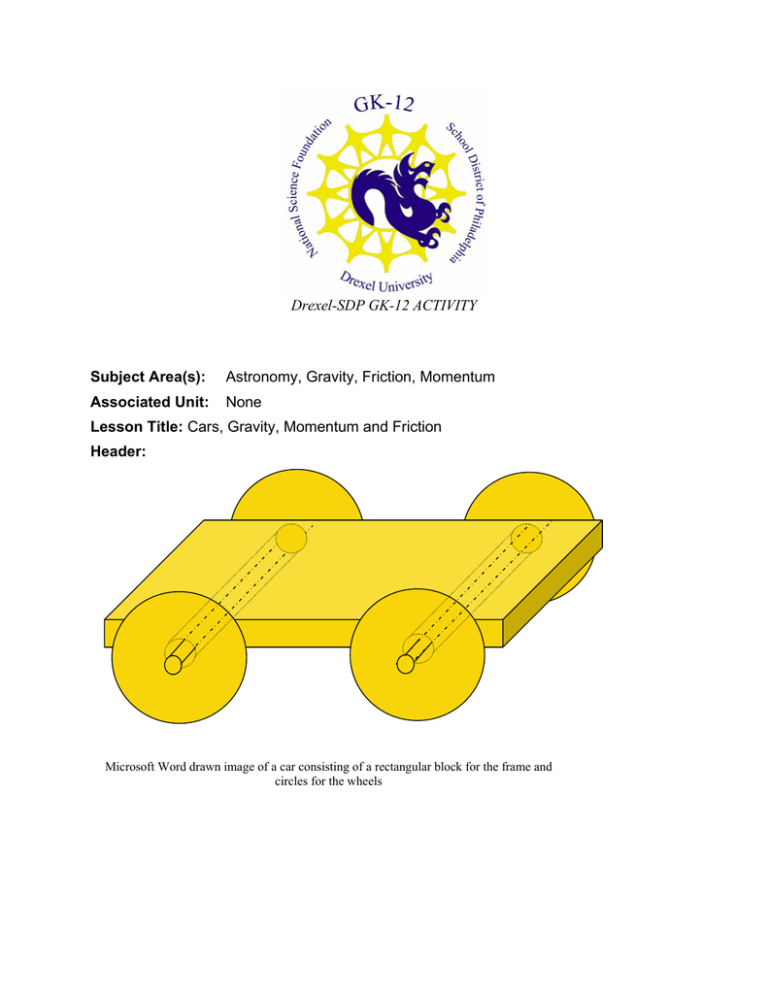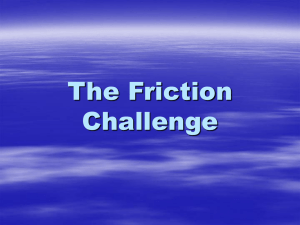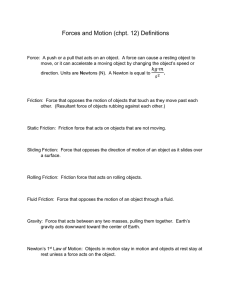Drexel-SDP GK-12 ACTIVITY Subject Area(s): Associated Unit:
advertisement

Drexel-SDP GK-12 ACTIVITY Subject Area(s): Astronomy, Gravity, Friction, Momentum Associated Unit: None Lesson Title: Cars, Gravity, Momentum and Friction Header: Microsoft Word drawn image of a car consisting of a rectangular block for the frame and circles for the wheels Grade Level 6 Lesson # 1 of 1 Time required: 1 hour Summary Students will utilize concepts of gravity, momentum and friction to design and build a car that will travel the furthest when being dropped down a ramp. Engineering Connection Engineers must be able to incorporate scientific principles into their designs. To come up with the best design, students must be able to understand the scientific principles of gravity, momentum and friction. Keywords Mass, Momentum, Velocity, Friction, Gravity, Astronomy, Acceleration Educational Standards • Science: 3.1.7, 3.2.7, 3.4.7, 3.7.7 • Math: 2.9 Pre-Requisite Knowledge Velocity = Change in distance over time. Think of other ways to write out mph (miles per hour or miles divided by hours) Learning Objectives After this lesson, students should be able to: • Understand how engineers can use scientific principles to improve their design • Learn how to design, build, test, optimize, rebuild and retest their cars • See how changes in gravity, momentum, and friction can affect distance traveled Introduction / Motivation What could we use to power a car other than an engine? What about gravity? How can we use gravity to increase the speed of a car? Would I have a better chance of surviving if I jumped off of a 2 foot high crate or off of the roof of the school building? Why would my impact be less by jumping off the 2 foot crate? Gravity causes objects (including us and cars going down a ramp) to accelerate. What is acceleration? What is another term for the gas pedal in a car? (the accelerator) Pushing on the gas pedal causes a car’s velocity to increase, aka accelerate. Acceleration is the change in velocity. Going from 0 to 60 mph is an example of acceleration. Next, go over momentum and friction and how the two are related in terms of a car going the long distance. Momentum is equal to mass times velocity. Therefore, if a guy on a bicycle 2 and a train are both traveling at 30 mph, which one has more momentum? The train b/c it has more mass (may need to review what mass is as well). For a car to travel the furthest distance, we want to maximize its momentum at the bottom of the ramp. Therefore, increasing mass would increase momentum, so why not just make the car as heavy as possible. What about friction? Friction is the resistance between two objects. Think about pushing one book across the floor. Now, think about pushing an entire stack of books across the floor. Which is easier, why? Friction increases with the mass of the books. Friction is a force that will cause our cars to slow down. If increasing mass will increase the forces of friction, then to minimize friction we would want to make the cars as light as possible. Think about other ways to minimize friction when designing your cars. What has less friction, wood against wood, or wood against a plastic straw? Also, notice that we in order to get the cars to travel the furthest, we want to increase moment by increasing mass, but also decrease friction by decreasing mass. Incorporating knowledge of these scientific principles is important to take into consideration when designing cars to travel the furthest. Lesson Background & Concepts for Teachers Although maximizing momentum and reducing friction are important, first make sure that the students can build a car that will go straight. Otherwise, the car that best utilizes these principles may not necessarily win. Students can add the wheels by either taping the wooden dowels directly to the cars or by taping the straws directly to the cars and putting the wooden dowels inside the straws. Using the straws is suggested b/c friction will be reduced. Vocabulary / Definitions Word Definition Gravity The attractions of the earth’s mass for bodies near its surface Momentum Mass times velocity Acceleration Change in velocity Friction Resistance between two objects Velocity Distance traveled over time Mass A property of a body that causes it to have weight in a gravitational field Associated Activities Materials Drill, Drill bit used to cut out door knobs, circular saw, electric sander or just sand paper and a lot of time Rectangular cut-outs of plywood (birch, spruce, or any other inexpensive wood will be fine). Cut-outs should be about 4” x 8”. Wooden dowels. Cut down to extend past the shorter part of the rectangular cut-outs. Should be small enough to fit inside a straw. Cut-out the wheels using a drill bit that is used to cut out the hole for door knobs. This will leave a hole in the center of the circle for the dowel. 3 Non-bendable straws. Tape Paper clips and binder clips. (used for both weight and if desired, to hold the wheels onto the dowels). A 4 foot sheet of plywood (for the ramp) Pre-Activity Preparation Cut-out all the wheels, frames, and wooden dowels ahead of time. When cutting out the wheels, they will need to be sanded down so that the edges are smooth. Allow yourself a couple of hours b/c if you are making these kits for an entire class, it will take a while. With the Students 1. Review with the students that their goal is to make a car that will travel the furthest distance when dropped down a ramp. 2. Review how the cars will be judged: Each car will be dropped from the exact same height and the point at which it stops will be marked off as the distance. 3. Hand out the frames, wooden dowels, wheels, straws and tape. You can leave the paper and binder clips in one place so that students can use as needed. 4. Allow the students time to design, build, test, redesign and rebuild their cars. 5. Give the students a time limit and once that time limit is reached, collect all the cars. 6. Have the groups come up one at a time to release their cars down the ramp (pushing of the cars results in a disqualification). Lesson Closure Investigating Questions - What types of things did you do to make the best design? - What were some of your questions? How did you answer those questions? - Take a look at the winning care, what about the car caused it to go the furthest? - What was the effect of increasing the weight of your cars? Lesson Extension Activities Besides distance, cars could also be tested for speed or even how close they get to a certain point. In order for cars to get to a certain, shorter, point, the students will have to take advantage better advantage of friction. References 4 Owner Drexel University GK-12 Program Contributors Jason Coleman Copyright Copyright 2008 Drexel University GK-12 Program. Reproduction permission is granted for nonprofit educational use. 5







